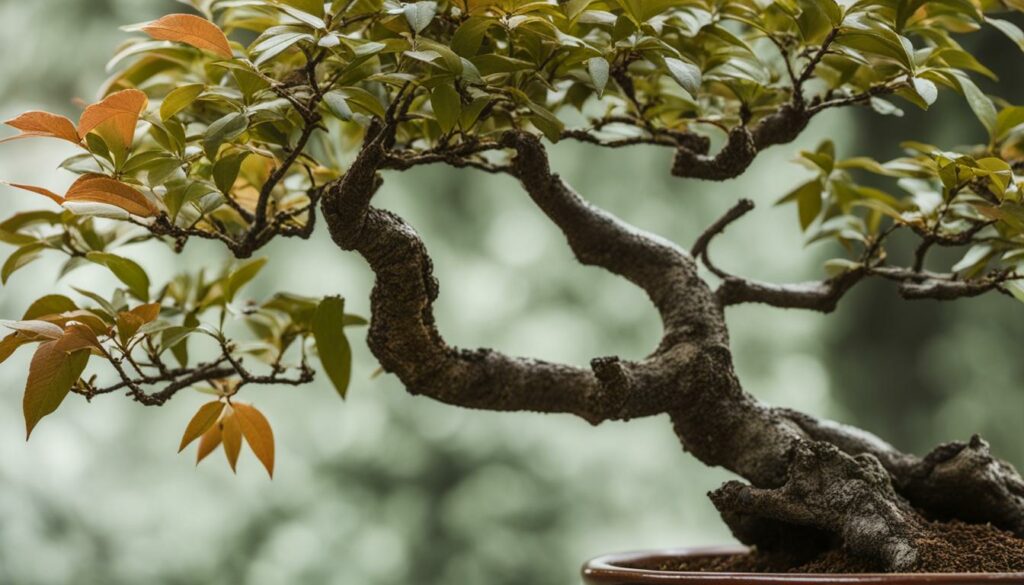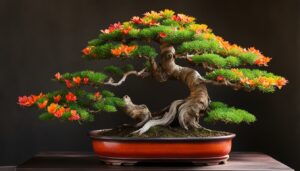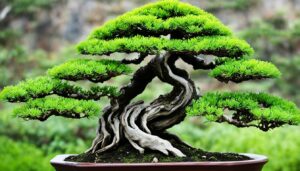If you’re a bonsai enthusiast looking for ways to enhance your tree’s refinement, control growth, and achieve aesthetic perfection, then defoliation may be the answer you’re searching for. Defoliation is a technique used in bonsai styling that involves the removal of leaves from a bonsai tree to achieve certain objectives.
In this article, we’ll take a closer look at the art of defoliation in bonsai styling. You’ll learn about the benefits, timing, and techniques of defoliation and how it can help you achieve your bonsai styling goals. By the end of this article, you’ll have a better understanding of how to utilize defoliation in your own bonsai endeavors.
Key Takeaways
- Defoliation is a technique used in bonsai styling to enhance tree refinement, control growth, and achieve aesthetic perfection.
- Removing leaves through defoliation can help control growth, promote ramification, and enhance overall refinement of the bonsai tree.
- Timing and frequency of defoliation should be considered to ensure proper tree health and growth patterns.
- Selective defoliation and leaf reduction can be utilized to fine-tune the overall aesthetic appearance of the bonsai tree.
- Experimenting with defoliation techniques can expand your knowledge and understanding of bonsai styling.
Understanding Bonsai Styling
Bonsai styling is an ancient Japanese art form that involves cultivating small trees that mimic the shape and scale of full-sized trees. The goal is to create a miniature landscape that looks like a fully grown tree in nature. Bonsai trees must be cared for with precision to achieve the desired aesthetic effect.
The techniques used to shape and design bonsai trees include pruning, wiring, and defoliation. Pruning involves carefully cutting off branches and leaves to control growth and promote the desired shape. Wiring involves wrapping thin wire around the branches to bend them into the desired shape. Defoliation, which we will discuss in detail, is the removal of leaves from the tree to achieve certain objectives.
By following these techniques, a bonsai enthusiast can shape a tree with remarkable accuracy, achieving a refined and aesthetic appearance. Defoliation is a key aspect of bonsai styling that promotes tree refinement and growth control, which we will explore in the following sections.
What is Defoliation?
Defoliation is a technique used in Bonsai Styling Defoliation to enhance tree refinement and promote leaf reduction. It involves the removal of leaves from a bonsai tree to achieve certain objectives. Defoliation is a common practice among bonsai enthusiasts and is often used to achieve a more aesthetic appearance in the tree.
The rationale for defoliation is to shock the tree into producing smaller leaves and buds which results in a more refined appearance. This treatment not only helps control the overall growth of the tree but also enhances the natural beauty of the tree’s branching structure by making it more visible.
“Defoliation, when done correctly, can really push a garden’s limits and fine-tune a tree’s appearance.” – Chris Kirkland
It’s important to note that defoliation should not be used on trees that are weak, diseased, or that have recently been repotted as this can cause additional stress and harm to the tree. It’s also essential to follow the proper defoliation techniques to ensure that the tree remains healthy and vibrant.
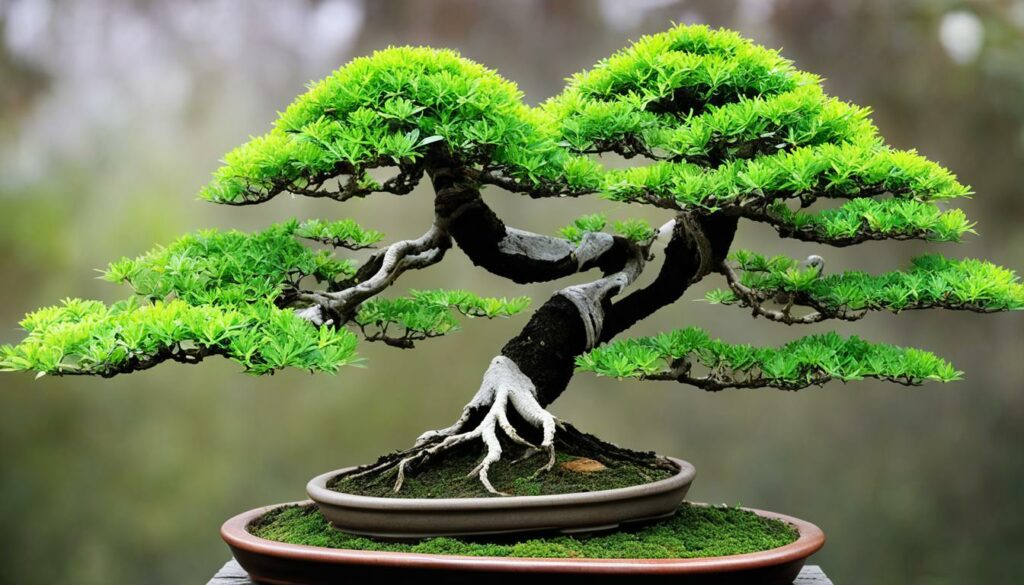
Defoliation and Leaf Reduction
Leaf reduction is a significant consideration when it comes to defoliation. Not only does defoliation help reduce the size and density of the leaves, but it also promotes the growth of smaller, more refined leaves. This can make a significant difference in the overall appearance of the tree and is a crucial component of bonsai styling.
Defoliation and Tree Refinement
As mentioned, defoliation can significantly enhance tree refinement in bonsai styling. By removing the leaves from certain parts of the tree, you can better see the branching structure and overall shape of the tree. This allows for more precise pruning and shaping, resulting in a more refined and aesthetically pleasing bonsai.
The Benefits of Defoliation
Defoliation is a powerful technique in bonsai styling that can bring numerous benefits to your tree’s health and appearance. By removing a tree’s foliage, you can control its growth, promote ramification, and enhance overall refinement, resulting in a more balanced and visually appealing tree.
Growth control is one of the most significant benefits of defoliation. By reducing a tree’s leaves, you can slow down its growth, redirecting nutrients to other areas of the tree that require more attention. This controlled growth can lead to a more compact, proportionate look to your bonsai tree, achieving balance and harmony.
Additionally, defoliation can enhance tree refinement by promoting the growth of smaller, finer branches. As a result, more refined and intricate growth patterns can be encouraged, refining the shape and silhouette of the tree.
In summary, defoliation is an essential technique in bonsai styling, playing a crucial role in controlling growth, promoting ramification, and enhancing overall refinement. As we will explore in the following sections, proper defoliation is essential to achieve the desired look of your bonsai tree.
When to Defoliate
Defoliation is a critical technique in bonsai styling, but it should only be applied under certain conditions. You should never defoliate a tree that is weak or unhealthy, as it may not have the energy to recover. Additionally, defoliation should only be performed during the growing season when the tree is actively producing new leaves.
The timing and frequency of defoliation will depend on the species and growth patterns of the tree. In general, deciduous trees are typically defoliated once a year, while evergreens may require less frequent defoliation. As a rule of thumb, it’s best to defoliate your bonsai tree when it has at least two or three flushes of new growth.
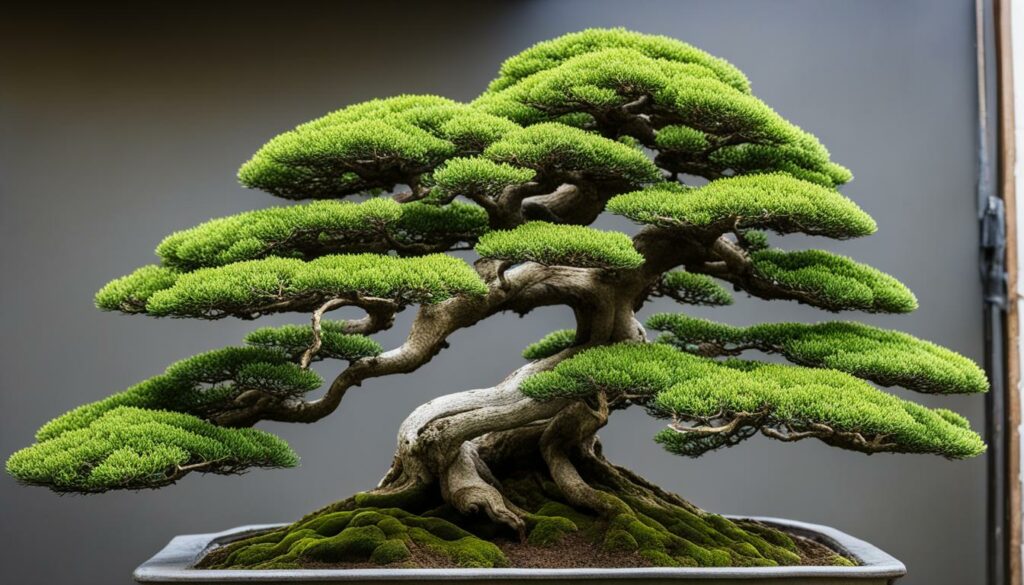
However, it’s important to note that defoliation should not be done excessively, as it can weaken the tree and lead to stunted growth. Over time, excessive defoliation can also impact the overall health and vitality of the tree. Therefore, it’s essential to exercise caution and monitor your tree’s response to defoliation carefully.
How to Defoliate
Defoliation is a delicate process that requires proper techniques and tools to ensure the bonsai tree’s health and vitality. Here are the steps on how to defoliate your bonsai tree:
- Choose the right time: It is best to defoliate during the growing season when the tree’s growth is at its peak. This will allow the tree to recover quickly and produce new growth.
- Prepare your tools: You will need a pair of sharp scissors or shears to remove the leaves. Ensure that your tools are clean and disinfected to prevent any diseases from spreading.
- Identify the leaves to remove: Remove the large leaves first, leaving behind small and healthy leaves. It is recommended that you remove only one-third of the total leaves to minimize stress on the tree.
- Make clean cuts: Use your scissors or shears to make clean cuts at the base of the petioles or leaf stems. Avoid tearing the leaves, as this can cause damage to the tree.
- Monitor the tree’s health: After defoliation, monitor the tree’s health and check for any signs of stress or disease. Water the tree regularly and provide adequate fertilization to encourage new growth.
Remember, defoliation should be done with caution and only when necessary. Improper defoliation can cause harm to the tree and affect its overall health and appearance.
Defoliation Techniques
Defoliation is a powerful technique used by bonsai enthusiasts to achieve various outcomes. Here we explore three primary defoliation techniques used in bonsai styling: partial defoliation, total defoliation, and selective defoliation.
Partial Defoliation
Partial defoliation is the process of removing select leaves from a bonsai tree to encourage new growth and create greater ramification. By thinning out certain areas of the tree, you can achieve a more balanced and aesthetically pleasing appearance. This technique is great for promoting a fuller canopy and controlling the overall shape of the tree.
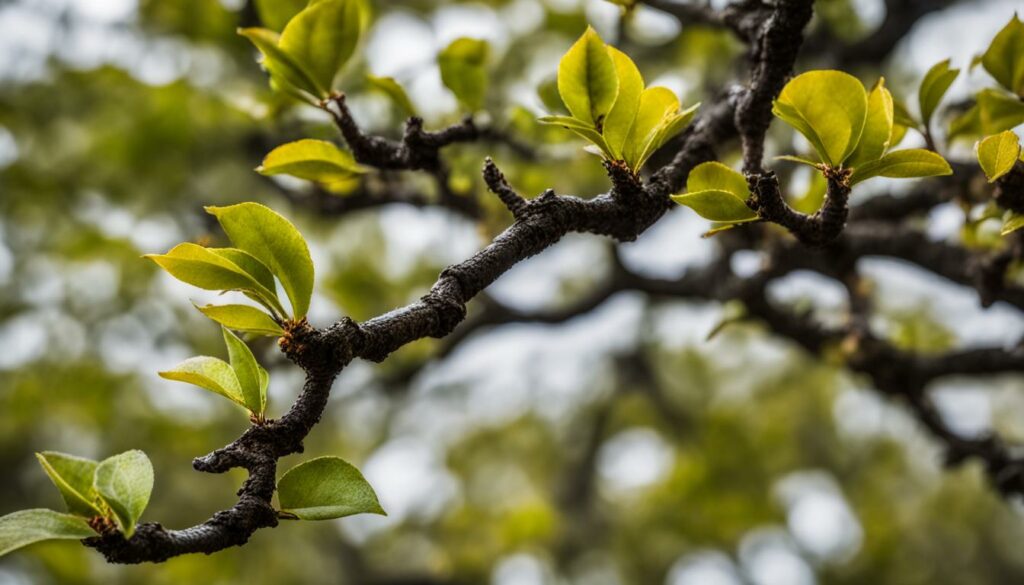
Total Defoliation
Total defoliation involves removing all of the leaves from a bonsai tree in one go. This extreme technique is typically reserved for advanced bonsai artists and should only be attempted on healthy, mature trees. The primary objective is to encourage fresh growth and refine the tree’s design. However, total defoliation can be risky and should only be performed by experienced hands.
Selective Defoliation
Selective defoliation is the process of removing leaves from select areas of the tree to control its growth and enhance its overall design. This technique is ideal for addressing problem areas and balancing the growth of the tree. By removing leaves from areas that tend to grow too quickly, you can encourage new growth in areas that require more development.
When choosing a defoliation technique, consider the age, health, and growth patterns of your bonsai tree. Consult with a bonsai specialist if you’re unsure which technique is best suited to your tree’s needs.
Recovering from Defoliation
Defoliation is a crucial technique in bonsai styling for controlling growth and achieving aesthetic perfection, but it can also cause stress to the tree. If done improperly, it can lead to weak or stunted growth or even death. So, how can you help your bonsai tree recover after defoliation?
First and foremost, it’s essential to provide your tree with the right growing conditions. Make sure it receives the proper amount of sunlight, water, and fertilizer in the weeks following defoliation. You may need to adjust your care routine slightly to account for the tree’s increased vulnerability during this period.
Another strategy is to prune your bonsai tree’s roots, which can stimulate new growth and improve overall health. This technique is known as root pruning and involves removing about a third of the root mass from the tree.
It’s also vital to be patient when waiting for your tree to recover. Remember that defoliation is a stressor, and it may take several months for your bonsai tree to fully recover. During this time, closely monitor the tree’s growth and make adjustments to your care routine as needed.
Remember: prevention is key when it comes to defoliation. By following proper techniques and guidelines, you can reduce the risk of stress and ensure your bonsai tree stays healthy and vibrant.
“Proper care and maintenance after defoliation are crucial to keeping your bonsai tree healthy and vibrant. With mindful attention and patience, your tree can recover and thrive.”
Defoliation and Styling Goals
Defoliation is a key technique in achieving the desired aesthetic perfection and refinement of a bonsai tree. By removing leaves, you can direct the growth pattern and promote ramification, leading to an overall more polished and elegant appearance. Defoliation is particularly useful for fine-tuning a tree’s design, ensuring that every branch and leaf is perfectly positioned to create the desired effect.
Whether you are aiming for a classic, formal upright style or a more contemporary look, defoliation can help you achieve your styling goals. By controlling growth and directing the tree’s development, you can create a truly unique bonsai that reflects your personal vision and style.
Defoliation plays an integral role in tree refinement, which is the process of shaping a bonsai tree to emphasize its natural beauty and unique features. By carefully removing leaves and directing growth, you can achieve a level of aesthetic perfection that is hard to achieve through other techniques.
The Importance of Patience
It is important to remember that defoliation is not a quick fix or a one-time solution. It is a technique that requires patience and careful attention to detail. By working slowly and methodically, you can ensure that your bonsai tree grows and develops in the direction you want, and that it becomes a true work of art.
Defoliation and Seasonal Considerations
When it comes to defoliation in bonsai styling, it’s essential to consider the season. Different seasons may impact the timing and effectiveness of defoliation, and it’s important to be mindful of these considerations to ensure the health and growth of your tree.
In the spring, defoliation can be used to control growth and create more compact foliage pads. However, it’s important to avoid defoliating too early in the season, as the tree needs time to recover before summer’s heat and sunlight.
In the summer, total defoliation should be avoided, as it can lead to sunburn and dehydration. Instead, partial defoliation can be an effective method for promoting ramification and enhancing tree refinement.
In the fall, defoliation can be used to refine a tree’s design and create a more balanced canopy. However, it’s important to complete defoliation at a time when the tree can still generate new growth to replace the leaves that have been removed.
Overall, seasonal considerations are a crucial element of defoliation in bonsai styling. By understanding the impact of different seasons and timing defoliation appropriately, you can ensure the health and vitality of your bonsai tree while achieving your desired tree refinement and growth control goals.
Common Mistakes to Avoid
While defoliation is an effective technique in bonsai styling, there are common mistakes that enthusiasts should avoid to achieve optimal results. Here are some potential pitfalls to keep in mind:
- Defoliating too much: Be careful not to remove too many leaves from your bonsai tree, as this could severely weaken the tree and stunt its growth.
- Defoliating at the wrong time: Timing is critical when it comes to defoliation. Defoliating during periods of active growth can harm the tree and interfere with its development.
- Defoliating unhealthy trees: Only defoliate trees that are healthy and strong. Defoliating sick or weak trees can further damage them and compromise their overall health.
- Not following proper defoliation techniques: It’s important to follow the proper techniques for defoliation to ensure that the tree is not harmed in the process. Improper defoliation techniques could lead to scars, damage to the buds, and other issues that could affect the health and aesthetic appeal of the tree.
By avoiding these mistakes and following proper defoliation techniques, you can achieve optimal results in controlling growth and achieving tree refinement.

Fine-Tuning with Defoliation
In bonsai styling, defoliation is more than just a control technique: it has a number of other applications as well. One of these is as a fine-tuning mechanism, allowing for the careful shaping and refinement of a bonsai tree’s appearance. One key aspect of this is leaf reduction, which can help to enhance the overall aesthetic appearance of the tree and bring it closer to achieving a perfect balance of form and function.
To achieve this level of perfection, however, it’s important to approach defoliation with care and precision. The process of removing leaves from a bonsai tree should be done methodically and deliberately, taking into account the tree’s unique growth patterns and shape. By doing so, you can create a more refined and visually appealing bonsai that truly captures the essence of this ancient art form.
One technique for achieving greater leaf reduction is to select specific leaves for removal, rather than simply stripping the tree of foliage. This can help to create a more nuanced and balanced appearance, as well as more closely aligning the tree with your desired styling goals. Careful, targeted defoliation can help to bring out the natural beauty of a bonsai tree, creating a work of living art that is both visually stunning and expertly crafted.
Experimenting with Defoliation
If you’re looking to take your bonsai styling skills to the next level, then experimenting with defoliation techniques is a great way to expand your knowledge and understanding of how to achieve tree refinement and control growth. There are countless approaches and techniques to explore, and the more you experiment, the more you’ll develop your own unique style and vision for your bonsai trees.
Remember to always approach defoliation with care and caution, taking into consideration the health and growth patterns of your tree. Start small, experimenting with targeted leaf removal and gradually working your way towards larger, more comprehensive defoliation techniques.
As you experiment and refine your defoliation skills, you’ll begin to see the incredible impact that this technique can have on your bonsai trees. Not only will you be able to control growth and achieve greater refinement, but you’ll also be able to use defoliation as a way to fine-tune and perfect the overall aesthetic of your trees.
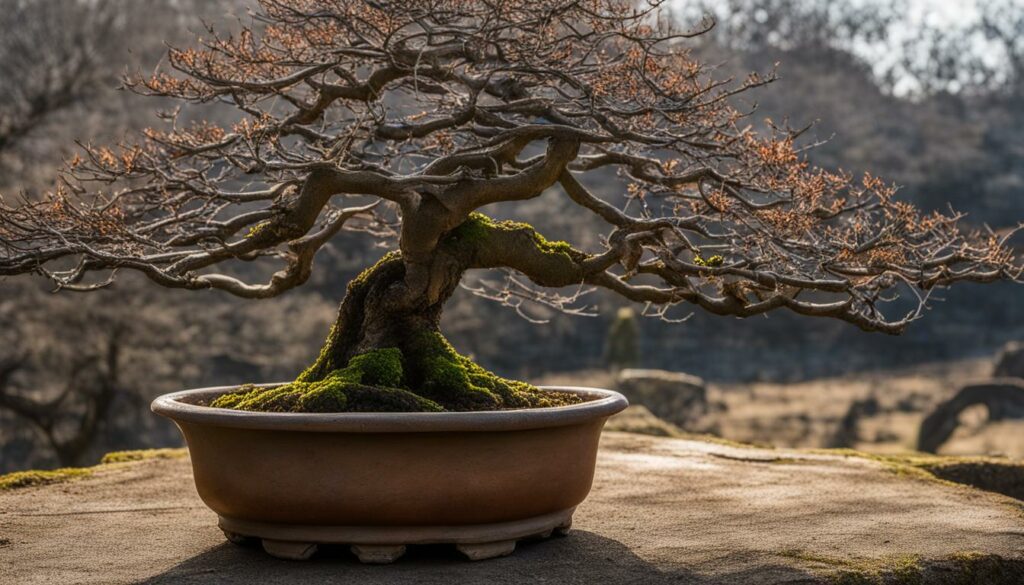
Some Tips for Experimenting with Defoliation
- Start with healthy trees that are strong enough to handle the defoliation process
- Be mindful of the timing and frequency of your defoliation techniques
- Experiment with different defoliation techniques, such as partial defoliation and total defoliation
- Observe the growth patterns of your tree after defoliation to understand its response
- Consider combining defoliation with other bonsai styling techniques, such as wiring and pruning, for greater control and refinement
Conclusion
Now that you have a better understanding of the art of defoliation in bonsai styling, you can begin incorporating this technique into your own tree refinement and growth control efforts. Remember that defoliation can help achieve the desired aesthetic perfection and refine the overall design of your bonsai tree.
By following the guidance provided in this article, you can defoliate your tree safely and effectively, taking into consideration the timing, frequency, and techniques that best align with your styling goals. Always prioritize the health and vitality of your tree, and be sure to avoid common mistakes that may harm its growth and development.
Experiment with different approaches and techniques to fine-tune your defoliation process, and stay attuned to the seasonal considerations that may impact its effectiveness. With a little patience, practice, and persistence, you can create beautiful and healthy bonsai trees that reflect your unique style and vision.
FAQ
What is defoliation in bonsai styling?
Defoliation in bonsai styling refers to the removal of leaves from a bonsai tree. It is done to achieve certain objectives such as tree refinement and leaf reduction.
What are the benefits of defoliation?
Defoliation offers several benefits in bonsai styling. It helps control the growth of the tree, promotes ramification, and enhances the overall refinement of the bonsai.
When is the best time to defoliate a bonsai tree?
The timing of defoliation depends on the health and growth patterns of the tree. It is best to defoliate during periods of active growth when the tree is healthy and strong.
How do I defoliate a bonsai tree?
To defoliate a bonsai tree, carefully remove the leaves using bonsai shears or scissors. Make sure to follow the appropriate techniques and precautions to maintain the tree’s health and vitality.
What are the different defoliation techniques used in bonsai styling?
Bonsai styling involves various defoliation techniques, including partial defoliation, total defoliation, and selective defoliation. Each technique has its own advantages and considerations.
How can I help my bonsai tree recover after defoliation?
To help your bonsai tree recover after defoliation, provide proper care and attention. This includes promoting new growth, maintaining tree health, and encouraging the tree to regain its desired aesthetic appearance.
How does defoliation align with the overall styling goals of a bonsai tree?
Defoliation plays a critical role in achieving the desired aesthetic perfection and refining the overall design of a bonsai tree. It helps in tree refinement and is a valuable technique for achieving the desired styling goals.
How do seasonal considerations affect defoliation in bonsai styling?
Seasonal variations impact the timing and effectiveness of defoliation. It is important to consider different seasons and their effects on tree growth and health when deciding when and how to defoliate.
What are some common mistakes to avoid when practicing defoliation?
Common mistakes to avoid when practicing defoliation include improper timing, excessive leaf removal, and neglecting to provide adequate aftercare. It is crucial to approach the process with caution and knowledge.
Can defoliation be used as a fine-tuning technique in bonsai styling?
Yes, defoliation can be used as a fine-tuning technique in bonsai styling. Targeted leaf reduction through defoliation helps enhance the overall aesthetic appearance and refine the design of a bonsai tree.
Is it recommended to experiment with different defoliation techniques?
Yes, bonsai enthusiasts are encouraged to experiment with different defoliation techniques to expand their knowledge and understanding. Experimentation allows for a deeper exploration of the impact of defoliation on tree refinement and growth control.
